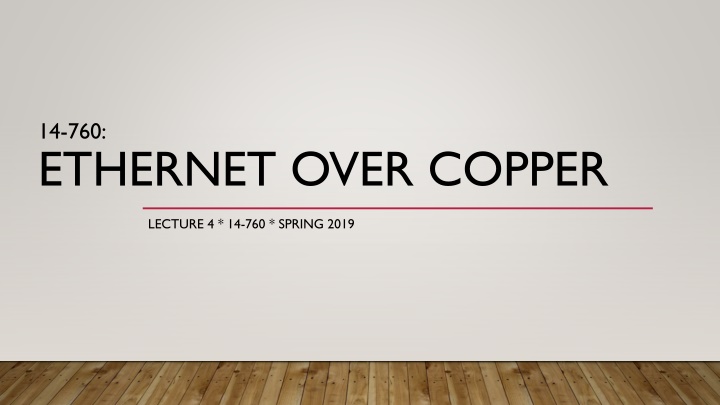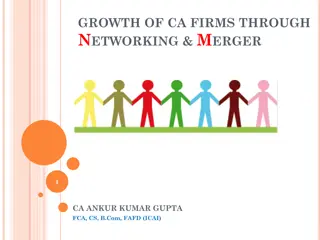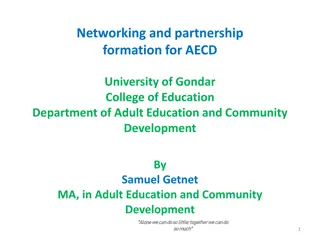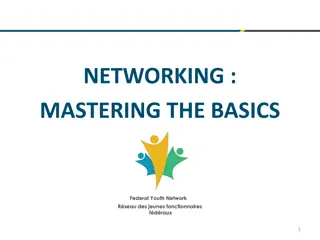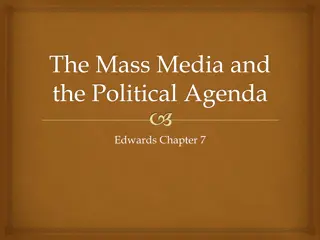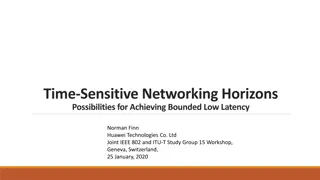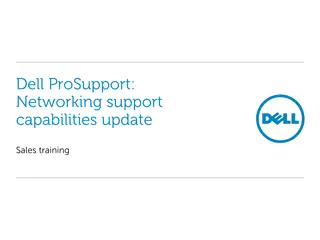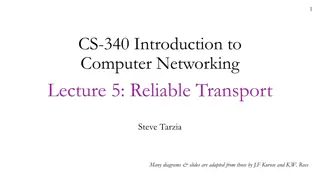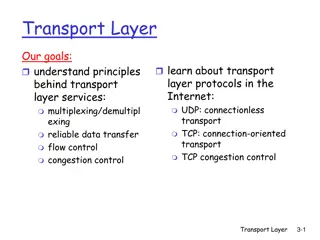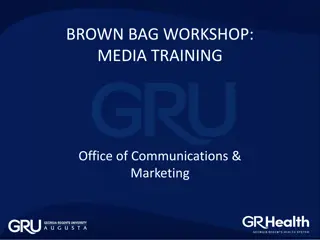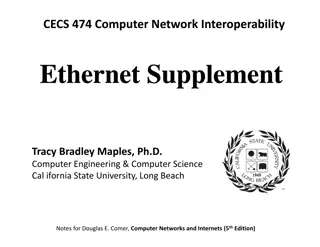Evolution of Media Access Control Protocols in Networking
Explore the history of contention-based MAC protocols starting from Pure Aloha to Slotted Aloha, Carrier Sense Multiple Access (CSMA), Persistent CSMA, and Nonpersistent CSMA. Learn how different strategies like slot boundaries and carrier sensing have evolved to minimize collisions and improve transmission performance in network communication.
Download Presentation

Please find below an Image/Link to download the presentation.
The content on the website is provided AS IS for your information and personal use only. It may not be sold, licensed, or shared on other websites without obtaining consent from the author.If you encounter any issues during the download, it is possible that the publisher has removed the file from their server.
You are allowed to download the files provided on this website for personal or commercial use, subject to the condition that they are used lawfully. All files are the property of their respective owners.
The content on the website is provided AS IS for your information and personal use only. It may not be sold, licensed, or shared on other websites without obtaining consent from the author.
E N D
Presentation Transcript
14-760: ETHERNET OVER COPPER LECTURE 4 * 14-760 * SPRING 2019
QUICK HISTORY PURE ALOHA (SATELLITE) Circa 1970 Originally developed for terrestrial radio at Univ. of Hawaii, it illustrates the principles of a contention-based MAC protocol on any broadcast media. Senders transmit whenever they want If any two transmission over lap even by one bit, they are garbled. This is called a collision. Collisions are detected by listening and verifying checksum. Garbled frames are resent after a random delay. Resent frames may also collide. Resending frames does, of course, waste the channel
QUICK HISTORY: PURE ALOHA (SATELLITE) A B C D E
QUICK HISTORY: SLOTTED ALOHA Circa 1972 Stations agree on slot boundaries. These might be maintained by a special station that produces a timing signal. Tolerance needs to be built in for timing signal s transmission latency Send only at beginning of slot. This reduces the window of vulnerability to a single frame s transmission time (1 slot) Of course, if contention is low and collision is not likely, it will increase average transmission latency.
QUICK HISTORY: SLOTTED ALOHA tic tic tic tic tic tic tic tic tic tic tic tic tic A B C D E
CARRIER SENSE MULTIPLE ACCESS (CSMA) What if, instead of using slots, we just listen first, and only transmit if no one else is? This means that collisions would only occur in the event of a tie two stations listened and then transmitted? This leads to much better performance the window of vulnerability is very small just the transmission latency.
PERSISTENT CSMA Under persistent CSMA stations continually sense the channel and transmit as soon as it is free. The problem is that a queue could have been building up during the prior transmission. This ensures almost certain collision to follow.
NONPERSISTENT CSMA Nonpersistent CSMA will transmit immediately if the channel is free. The recent past is a good indicator of the near future. A collision isn t likely. If however, a station listens and hears a transmission, it stops listening and waits a random amount of time before trying again. This helps to mitigate the queuing of requests during a transmission from leading to a collision
P-PERSISTENT CSMA p is a parameter. It specifies the probability with which a station should transmit upon detecting an idle channel. In other words, if the channel is free, a station begins to transmit immediately with a probability of p. The other (1-p) time, the station waits a random amount of time. After this random delay, it rolls the dice again and transmits or waits, accordingly. This system is designed to further reduce the likelihood of collision by spreading out bursts.
HOW WELL DO THEY WORK? 1 0.01-persistent 0.9 non-persistent 0.8 0.1-persistent 0.7 S (throughput per packet time) 0.6 0.5 0.4 0.3 0.5-persistent S-Aloha 0.2 1-persistent 0.1 P-Aloha 2 1 3 5 6 7 8 9 4 G (Number of attempts per packet)
CSMA/CD Another level of sophistication is the addition of collision detection. Stations listen while transmitting If a station hears something different than what it is sending, it immediate stops What it hears is different from what it sends, if another transmission garbles the original. Additionally, if any station detects a collision, it sends a jamming signal to make sure that the colliding signals don t cancel each other out, preventing detection after attenuation. This reduces the time wasted in the event of a collision sending already garbled packets. IEEE 802.3 (including Ethernet) protocols are 1-persistent CSMA/CD.
MINIMUM FRAME SIZE FOR CSMA/CD Because of latency, collisions cannot be detected immediately. This signal from one transmitter much reach the other transmitter. In practice, this imposes a minimum size on the length of a frame. The frame must be long enough to permit a collision to be detected. If the frame is too short, it will be gone before the signal from one transmitter reaches another. The frames will be corrupted as the cross in the mail But neither sender will be able to detect it, until the whole frame has been sent, which defeats the purpose.
MINIMUM FRAME SIZE FOR CSMA/CD The frame needs to be sufficiently long to require more than a round-trip time for transmission. We must consider the bit-rate of the channel as well as its length to determine the round trip time. The frame must require more than this round-trip time for transmission. B*S B bits/second S seconds B*S bit time Sender1 Sender2 Sender 1 must wait for its frame to (almost) make it to Sender2, when the collision occurs, and then for the energy from Sender2 s frame to make it back, before detecting the collision. Sender2 detects the Collision almost immediately
ETHER NET Presented at 1976 National Computer Conference 3 Mbps Key improvement of satellite based Aloha Net Backoff was exponential random, not just random More load = more retries = more delay http://www.ieee802.org/3/ethernet_diag.html Circa 1973 Robert Metcalf s Memo @ Xerox PARC
1ST IEEE 802.3 STANDARD 1985 Half-duplex One pair of wires, send or receive, but not both simultaneously CSMA/CD Listen before sending to reduce likelihood of collision Listen while sending to detect collision if messages cross Forces minimum message size https://en.wikipedia.org/wiki/Coaxial_cable 10 Mb/s Medium Attachment Unit (MAU) for coaxial cable bus topology Heavily insulated and shielded
EVOLUTION MILESTONES 1988: Twisted Pair (Among other cabling) 1995: 100Mbps 10 years after 1st standard 1997: Full duplex 1998: Gigabit (1000Mbps) https://en.wikipedia.org/wiki/Twisted_pair 2002: 10 Gps (10,000Mbps) 2010: 40Gps and 100Gps standards
PROTOCOL STACK MAC Client = Higher level protocol MII = Medium Independent Interface MDI = Medium Dependent Interface http://docwiki.cisco.com/wiki/Ethernet_Technologies
ETHERNET FRAME http://docwiki.cisco.com/wiki/Ethernet_Technologies
GIGABIT ETHERNET: FRAME SIZE CHALLENGE Detecting Collision requires a frame size = RTT bit distance Without this a collision cannot be heard by the sender As data rate increases Either minimum frame sizes increases Or maximum segment length decreases Prior solutions cut network length 20M wouldn t quite cut it for gigabit ethernet
GIGABIT ETHERNET FRAME: SOLUTION, PART 1 http://docwiki.cisco.com/wiki/Ethernet_Technologies Add extension bits to make small frames larger
GIGABIT ETHERNET FRAME: SOLUTION, PART 2 http://docwiki.cisco.com/wiki/Ethernet_Technologies Allow a burst of frames An extension in only required after the first one, so it is compliant The IFG is filled with bits, so the carrier is never quiet.
ENCODING: Too many ones or zeros in a row are hard to clock Sender and receiver might time long sequence of high or low voltage differently Made worst by AC Coupling, e.g. use of capacitance as high-pass noise filter Capaciters have charge-discharge curves. They aren t flat. Rounding, esp. at edges. Transitions synchronize clocks Need a coding that guarantees transitions
BASELINE WANDER FROM CAPACITANCE Example of impact of capacitance as high-pass filter. http://docwiki.cisco.com/wiki/Ethernet_Technologies
OLD SOLUTION: MANCHESTER ENCODING 0 = rising transition 1 = falling transition 0 1 1 0 1 transitions per bit, but twice as much bandwidth High-low pattern has good electrical properties Balanced signal no net DC voltage. This allows AC coupled power supply on receiver. If code had a DC bias, it would be lost in the transformer on the receiver side.
CHALLENGES TO MANCHESTER ENCODING Requires a clock rate of 2x data rate Just can t work for higher data rates The frequency space isn t high enough Modern ethernets, e.g. gigabit use specific bit encodings Specific bit patterns are encoded in larger patterns to guarantee transitions But, not 2x as long
MODERN ETHERNET ENCODINGS: FORWARD ERROR CORRECTION Block-based schemes Encode redundancy in stream Gigabit ethernet Trellis coding, a type of lattice-based convolution Implicit FEC 10G ethernet Reed Soloman Encoding Used across many transmission and storage domains Block based forward error corretion
802.3 PHY COMPARISON https://www.standardsuniversity.org/e-magazine/august-2016- volume-6/evolution-ethernet-standards-ieee-802-3-working- group/
PHYSICAL LAYER: TWISTED PAIR COMPARISON https://en.wikipedia.org/wiki/Ethernet_over_twisted_pair
10MBPS 10-BASE-T Cat-3 or Cat-5 4-pair cable 2 pairs unused RJ45 8-pin connector http://docwiki.cisco.com/wiki/Ethernet_Technologies
GIGABIT ETHERNET (1000MBS) Shielded Twisted Pair (STP) Unshielded Twisted Pair (UTP) http://docwiki.cisco.com/wiki/Ethernet_Technologies
GIGABIT ETHERNET (1000MBS): 1000BASE-T PAM5 Encoding Pulse Amplitude Modulation 5-level http://docwiki.cisco.com/wiki/Ethernet_Technologies
GIGABIT ETHERNET (1000MBS): 1000BASE-T Maintaining the clock: Start of Frame Delimiters End of frame delimiters Idle codes during inter-frame gap http://docwiki.cisco.com/wiki/Ethernet_Technologies
